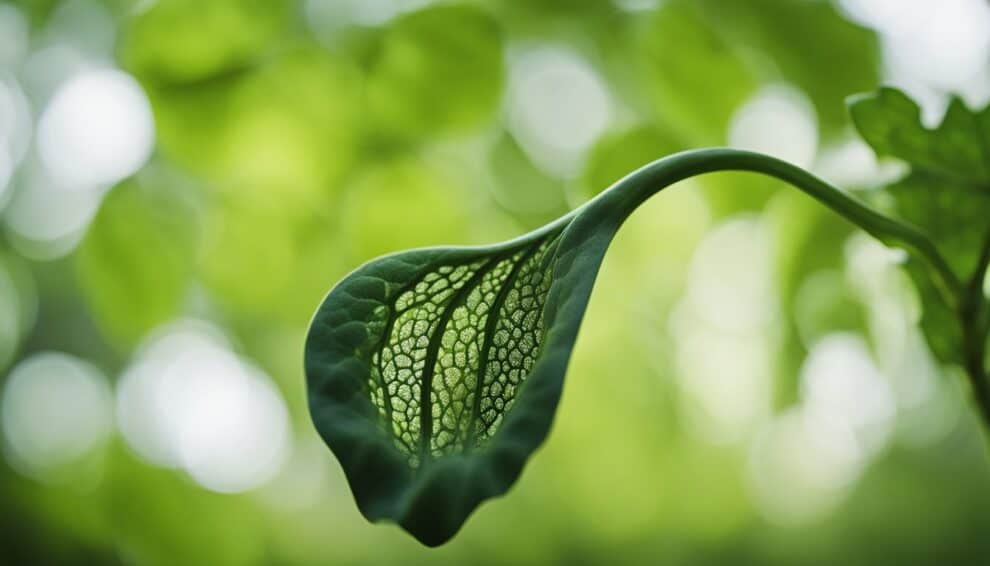Aristolochia Gigantea, commonly known as Dutchman’s Pipe, is a fascinating plant that belongs to the Aristolochiaceae family.
The plant is native to South America and is widely known for its unique flowers that resemble a Dutchman’s pipe.
The plant’s name is derived from the Greek words “aristolochia,” which means “best for childbirth,” and “gigantea,” which means “giant.”

The Dutchman’s Pipe plant is a woody vine that can grow up to 30 feet long.
It has large, heart-shaped leaves that can grow up to 10 inches in length and 8 inches in width.
The plant produces large, trumpet-shaped flowers that are about 6 inches long and 3 inches wide.
The flowers are greenish-yellow in color with purple veins, and they emit a strong, unpleasant odor that attracts flies for pollination.
Despite its unique appearance, the Dutchman’s Pipe plant is not commonly grown in gardens.
This is because the plant is toxic and can cause severe health problems if ingested.
However, the plant has been used in traditional medicine to treat a variety of ailments, including asthma, arthritis, and snake bites.
In recent years, the plant has also gained attention for its potential use in cancer treatment.
Botanical Profile of Aristolochia Gigantea
Aristolochia Gigantea, commonly known as Dutchman’s Pipe, is a fast-growing vine native to South America.
It belongs to the Aristolochiaceae family and is known for its unique and intriguing flowers that resemble a pipe.
The plant can reach a height of up to 30 feet and has large, heart-shaped leaves that are 6-10 inches long.
The flowers of Aristolochia Gigantea are the main attraction of this plant.
They are trumpet-shaped, with a curved tube that resembles a Dutchman’s pipe.
The flowers can grow up to 8 inches long and 4 inches wide, and are usually greenish-yellow in color with purple veins.
The flower emits a strong, unpleasant odor that attracts insects for pollination.
Aristolochia Gigantea is a hardy plant that can tolerate a wide range of soil types and growing conditions.
It prefers full sun to partial shade and requires regular watering during the growing season. The plant can be propagated through stem cuttings or by seed.
While Aristolochia Gigantea is a beautiful and intriguing plant, it is important to note that it contains aristolochic acid, a compound that can be toxic to humans and animals if ingested.
Therefore, it is important to handle the plant with care and keep it out of reach of children and pets.
Overall, Aristolochia Gigantea is a unique and fascinating plant that is sure to add interest to any garden or landscape.
Cultivation and Care

Planting Guidelines
When planting Aristolochia Gigantea, it is essential to choose the right location. The plant requires plenty of sunlight and well-draining soil.
It is recommended to plant the Dutchman’s Pipe in a spot that receives at least six hours of direct sunlight per day.
The soil should be rich in organic matter and well-draining, as the plant does not tolerate waterlogged soil.
The ideal time to plant Aristolochia Gigantea is in the spring, once the frost has passed.
Before planting, it is recommended to prepare the soil by adding compost or well-rotted manure.
Dig a hole that is twice the size of the root ball and place the plant in the hole, making sure the top of the root ball is level with the soil surface.
Water the plant thoroughly after planting to help settle the soil.
Growth Requirements
Aristolochia Gigantea grows best in warm, humid climates.
The plant can tolerate temperatures down to 20°F (-6°C) but prefers temperatures between 50°F to 85°F (10°C to 29°C).
To encourage growth, it is recommended to fertilize the plant with a balanced fertilizer every two weeks during the growing season.
The Dutchman’s Pipe is a fast-growing vine that can reach heights of up to 30 feet (9 meters).
The plant requires support to climb, so it is recommended to provide a trellis or other structure for the plant to climb.
Maintenance and Pruning
Aristolochia Gigantea requires regular maintenance to keep it healthy and looking its best.
The plant should be watered regularly, especially during dry spells. It is recommended to water deeply once a week, rather than shallowly every day.
Pruning is also essential to keep the plant in check and promote healthy growth.
The best time to prune Aristolochia Gigantea is in the late winter or early spring before new growth appears.
Prune any dead or damaged branches and cut back any overgrown branches to promote new growth.
In conclusion, Aristolochia Gigantea is a fascinating plant that requires some care and attention to thrive.
By following these planting guidelines, growth requirements, and maintenance and pruning tips, gardeners can enjoy the beauty of the Dutchman’s Pipe in their own gardens.
Ecological Impact and Uses

Environmental Adaptations
Aristolochia Gigantea, also known as the Dutchman’s Pipe, is a fascinating plant that has adapted to various environments.
It is native to South America, where it can be found in tropical rainforests, but it has also been introduced to other parts of the world, including Asia and Africa.
The plant is known for its ability to thrive in both wet and dry environments.
It can tolerate drought and flooding, making it a valuable plant for areas with unpredictable weather patterns.
Traditional and Medicinal Applications
The Aristolochia Gigantea plant has been used for centuries in traditional medicine.
The leaves, stems, and roots of the plant contain various compounds that have been used to treat a variety of ailments.
In South America, the plant has been used to treat respiratory infections, digestive problems, and skin conditions.
It has also been used as a natural insecticide and as a treatment for snake bites.
Despite its traditional uses, Aristolochia Gigantea has been found to be toxic to humans and animals when ingested.
The plant contains aristolochic acid, which has been linked to kidney damage and cancer. As a result, the plant is no longer recommended for medicinal use.
In addition to its medicinal uses, Aristolochia Gigantea is also used for ornamental purposes.
Its unique flowers, which resemble a Dutchman’s pipe, make it a popular choice for gardeners and landscapers.
The plant is also used in traditional ceremonies and celebrations in some cultures.
Overall, Aristolochia Gigantea is a fascinating plant with a rich history of traditional uses.
While it is no longer recommended for medicinal use, it continues to be valued for its ornamental and cultural significance.
Potential Risks and Controversies

Toxicity Concerns
While Aristolochia Gigantea, also known as the Dutchman’s Pipe, is a beautiful and intriguing plant, it is important to note that it contains aristolochic acid, a compound that has been linked to kidney damage and cancer in some studies.
While the levels of aristolochic acid in the plant are not high enough to cause harm through casual contact, ingestion of the plant or its extracts can be dangerous.
It is recommended that individuals avoid consuming any part of the Aristolochia Gigantea plant or using it in any medicinal preparations due to its potential toxicity.
Invasive Species Considerations
Another potential concern with Aristolochia Gigantea is its potential to become an invasive species in certain regions.
This plant is native to South America but has been introduced to other parts of the world, including the United States.
In areas where the plant is not native, it can outcompete native species for resources and disrupt local ecosystems.
It is important to consider the potential impact of introducing Aristolochia Gigantea into new areas and to take steps to prevent its spread.
Overall, while Aristolochia Gigantea is a fascinating and beautiful plant, it is important to be aware of its potential risks and to take appropriate precautions when handling or using it.
Frequently Asked Questions

What are the ideal growing conditions for Dutchman’s Pipe plants?
Dutchman’s Pipe plants thrive in warm and humid environments.
They prefer well-draining soil that is rich in organic matter, and they require partial to full shade.
It’s important to keep the soil consistently moist but not waterlogged.
How can I propagate the Dutchman’s Pipe to grow more plants?
Dutchman’s Pipe can be propagated through stem cuttings or by layering.
Stem cuttings should be taken in the spring or fall and placed in a well-draining potting mix.
Layering involves burying a portion of the stem in soil and allowing it to root before separating it from the mother plant.
Are there any common pests or diseases that affect the Dutchman’s Pipe?
Dutchman’s Pipe is susceptible to spider mites, aphids, and mealybugs.
They can also be affected by fungal diseases such as powdery mildew and leaf spot.
Regular inspection and treatment with an appropriate pesticide or fungicide can help prevent these issues.
What is the significance of the Dutchman’s Pipe’s unique flower shape?
The Dutchman’s Pipe’s flower shape is thought to have evolved to attract specific pollinators, such as pipevine swallowtail butterflies.
The flowers are shaped like a pipe, with a curved entrance that traps the butterfly inside.
The butterfly is then covered in pollen before being released, allowing for pollination to occur.
How often should I water my Dutchman’s Pipe plant?
Dutchman’s Pipe plants should be watered regularly to keep the soil moist but not waterlogged.
The frequency of watering will depend on the humidity and temperature of the environment, but generally, they should be watered every 7-10 days.
Can the Dutchman’s Pipe be grown indoors, and if so, how?
Dutchman’s Pipe can be grown indoors but requires a warm and humid environment with plenty of indirect sunlight.
They should be planted in a well-draining potting mix and kept consistently moist.
To encourage growth, they can be fertilized every 2-3 months with a balanced fertilizer.














